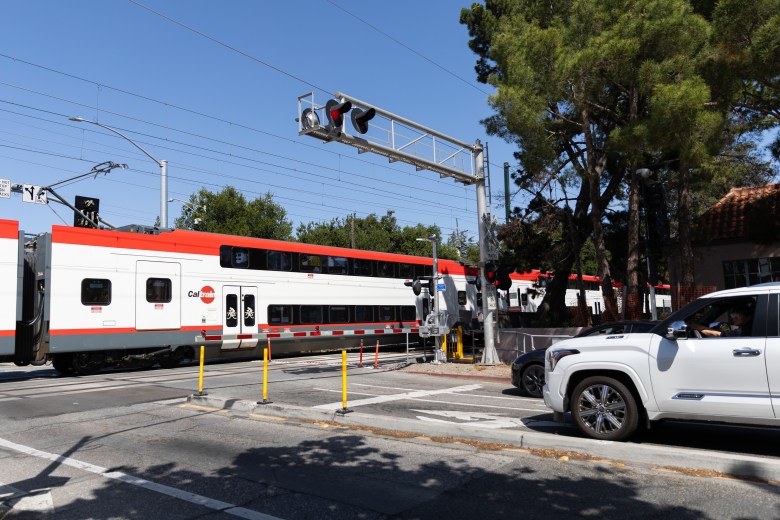
Any Palo Alto resident who lives near the Caltrain tracks is familiar with the horn. It sounds four times as the train approaches a railroad crossing, with a volume between 96 and 110 decibels to comply with federal regulations.
Between Palo Alto's four railroad crossings, every train passing through the city must honk 16 times, starting as early as 5 a.m. and as late as 1 a.m. They are intended to warn drivers and pedestrians of an oncoming train, but they also mean that neighbors cannot sleep well at night.
“I have a new neighbor with a 5-year-old who wakes up every night with this freight train in the middle of the night,” said resident Rachel Croft at the Nov. 10 City Council meeting.
The harsh train noise could soon be a thing of the past after the city council unanimously approved a plan on Monday evening that would waive the requirement to honk in favor of strengthening the barriers at three intersections.
Federal law requires trains to sound their horn between 15 and 20 seconds before reaching a railroad crossing. However, with an adequate four-quadrant gate system in place to block traffic, the intersections can be designated as a “quiet zone,” thereby replacing the need for a horn.
The northernmost ground level crossing on Palo Alto Avenue is already under construction for a quiet zone project. Now, upgrades have been approved for the remaining three intersections, Churchill Avenue, East Meadow Drive and Charleston Road.
Under the timeline suggested by Kimley Horn's consultants, construction will take more than two years because the city will need to hire additional consultants, review the designs, obtain approval from the California Public Utilities Commission and turn the project over to Caltrain for construction. Financing the project will cost the city between $4.1 million and $5.6 million.
Four-quadrant systems are also needed as a workaround for a future high-speed rail system, should Caltrain ever pursue it, according to a report from the city's transportation department.
Some residents have expressed concerns that the more robust gate system could instead have the negative effect of trapping cars on the tracks. However, according to Kimley Horn's report, the CPUC requires quad-gate systems to have occupancy sensors, meaning they will not lower if a car remains on the tracks.
The city has previously toyed with the idea of installing bugles as an alternative to train horns and four-quadrant gates. The idea behind the away horns is that the horn is not sounded in all directions by the train itself, but rather is attached to the intersection and directed at potential oncoming traffic – and also at adjacent parts of the city.
Residents who spoke at the Nov. 10 meeting urged the council to consider the gate option instead, arguing that the horns would provide an inadequate solution to the noise pollution problem. Councilor Julie Lythcott-Haims also raised concerns that there were a lack of suppliers to supply roadside horns and that maintenance could prove difficult down the road.
“The quiet zone is a more comprehensive benefit, but it takes longer and costs much more (than wayside bugles). We don't have the money right now, although there are potential sources we can use for it,” said Councilman Pat Burt.
City staff and consultants also determined that the barrier system could improve intersection safety more than any horn system, whether on the train or mounted at the intersection.
“Compared to wayside horns, the four-quadrant gate system would increase the barrier to access to the tracks and reduce the risk of gate passages, thereby reducing the ability of users to enter the track while a train is traveling in the area,” staff wrote in a report.
The city must also compete plans for four-quadrant gates with grade segregation proposals at the same three intersections. Either by building tunnels under the tracks or by building them above traffic, separating the tracks would eliminate the need for a quiet zone at all.
But these proposals are still in the early draft stages and could take decades and millions of dollars to implement. Meanwhile, city officials appeared to be mindful of the urgency of residents who want an end to their sleepless nights while maintaining alternative safety measures to protect traffic at intersections.
“My neighborhood is getting full horn exposure, so my neighbors are big fans and want it tomorrow,” said Councilman Keith Reckdahl.
